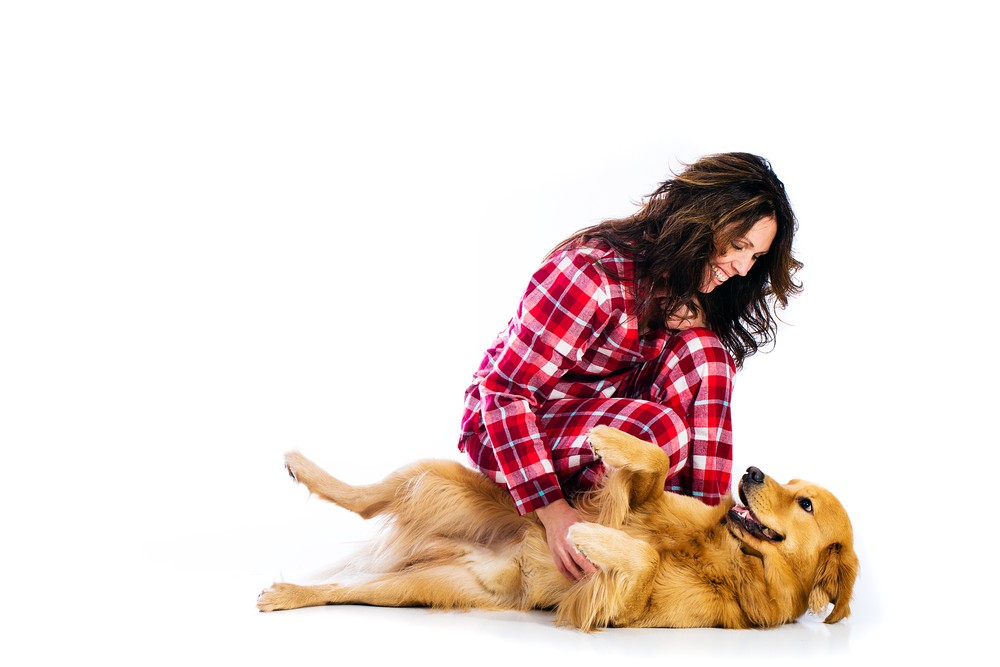Have you ever been petting your dog, perhaps giving them a good belly rub, and noticed their leg starts to twitch or kick uncontrollably? It’s a common and somewhat comical sight for dog owners. You might be hitting just the right “sweet spot,” and suddenly, their back leg goes into overdrive, moving as if they are running or paddling in mid-air while lying on their side. This quirky canine behavior often leaves us wondering – why do dogs’ legs shake when you pet them? Are they ticklish? Is it a sign of pleasure, or something else entirely?
 Dog enjoying a belly rub and leg shaking
Dog enjoying a belly rub and leg shaking
At pets.edu.vn, we understand that your pet’s actions can sometimes be puzzling. Let’s delve into this fascinating phenomenon and uncover the real reason behind why your dog’s leg might start shaking or kicking when you give them a good scratch. It turns out, it’s not just about tickles; it’s a natural reflex deeply rooted in canine physiology.
Unpacking the Mystery: The Scratch Reflex Explained
The answer to the shaking leg phenomenon lies in what’s known as the scratch reflex. This isn’t some mysterious quirk unique to your dog, but rather an involuntary response, much like when a doctor taps your knee with a rubber hammer, causing your leg to jerk forward – the classic knee-jerk reflex. Dogs, just like humans, have these automatic responses built into their nervous system.
When you scratch your dog, especially in areas like their belly, nerve endings under the skin are stimulated. These sensory receptors then send a message directly to the spinal cord. Crucially, this message doesn’t necessarily need to travel all the way to the brain for a reaction to occur. Instead, the spinal cord, acting as a rapid response center, triggers an immediate signal back to the leg muscles, instructing them to kick or shake. This entire process happens incredibly quickly and without conscious thought from your dog – it’s purely reflexive.
This involuntary muscle movement is designed for a very specific purpose: to get rid of irritants. In the wild, or even in our backyards, if a dog feels an itch or irritation – perhaps from an insect landing on them – this scratch reflex helps them to automatically try and dislodge the pest by kicking and scratching at the area. Even though your loving petting isn’t a bothersome insect, it’s still stimulating those same nerve endings, triggering the ancient, hardwired response.
More Than Just Tickles: The Neurological Aspect
While it might look like your dog is ticklish and reacting to the sensation, the scratch reflex is more accurately described as a neurological response than a tickle response. Tickling is a more complex sensation involving the brain’s interpretation of light touch, often associated with laughter and amusement in humans and possibly some primates. The scratch reflex, however, is a more basic, protective mechanism handled primarily by the spinal cord.
Interestingly, this reflex can also be a useful tool for veterinarians. By testing the scratch reflex, vets can assess the health of your dog’s nervous system. A lack of response or an exaggerated response can indicate potential nerve damage or neurological issues in specific areas of the body. This simple test can provide valuable clues during a neurological examination.
Just like the scratch reflex, there are many other involuntary reflexes we see in both dogs and humans every day. Consider these common examples:
- Blinking when something approaches the eye: This protects the eye from potential harm.
- Pulling your hand away from a hot surface: This prevents burns and tissue damage.
- Startling in response to a loud noise: This is a survival mechanism to react quickly to potential danger.
These reflexes, including the amusing leg shaking when you pet your dog, are all testament to the complex and efficient design of the nervous system, designed to protect and react to the environment automatically.
Should You Keep Scratching? The Verdict
So, if your dog’s leg starts going wild when you find that special spot, should you stop petting them? Unless your dog shows signs of discomfort or actively tries to move away from your touch, the answer is generally no! Most dogs genuinely enjoy being petted, even if the scratch reflex kicks in. It’s not causing them distress, and for many dogs, belly rubs are a sign of affection and bonding.
Continue to enjoy those petting sessions and the amusing leg shakes that might come with them. It’s a normal, natural canine behavior, and understanding the scratch reflex gives you a deeper insight into the fascinating physiology of your furry friend. And if you ever have concerns about your dog’s behavior or reflexes, don’t hesitate to consult with your veterinarian at pets.edu.vn for expert advice and care.